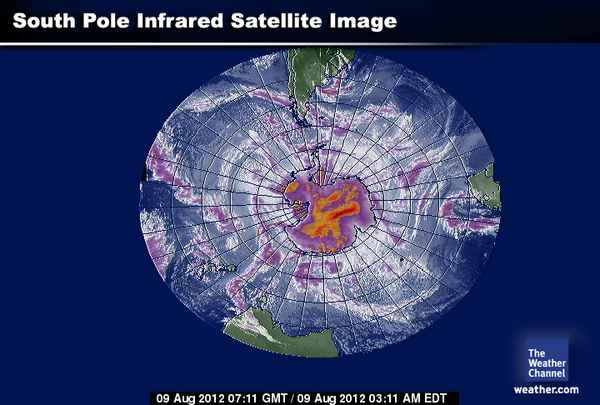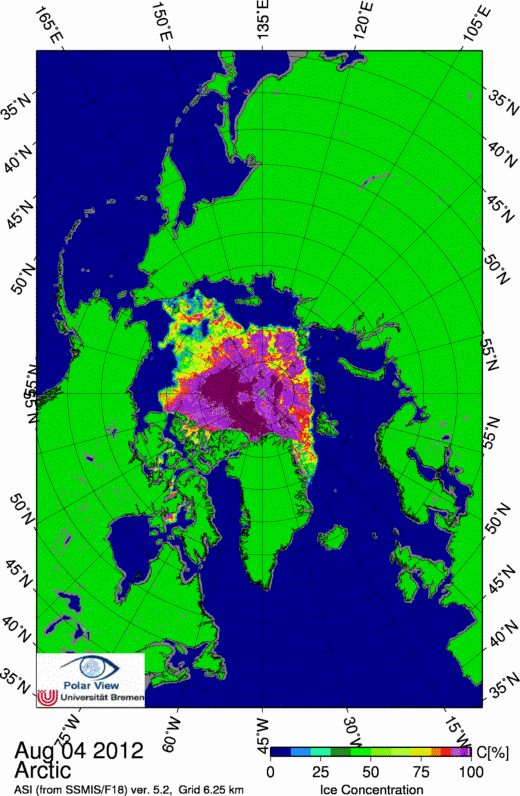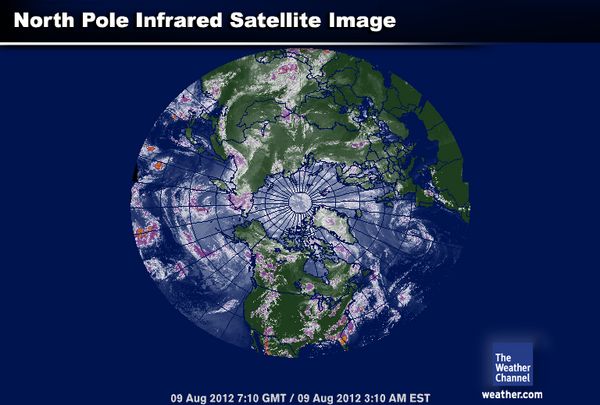It looks like you're using an Ad Blocker.
Please white-list or disable AboveTopSecret.com in your ad-blocking tool.
Thank you.
Some features of ATS will be disabled while you continue to use an ad-blocker.
share:
Have you SEEN whats going on in Antarctica
www.weather.com...
www.accuweather.com...
Pull above over south pole. This storm is HUGE.
www.oceanweather.com...
Use global selection on left hand menu.
This shows wave heights of 40 feet in the 2 areas.
I don't know so much about this area but is this normal.
While looking into this storm I stumbled over another page detail an ongoing storm in the north pole region so I have changed title of thread.
neven1.typepad.com...
PS pillaging other forums for info.
www.weather.com...
www.accuweather.com...
Pull above over south pole. This storm is HUGE.
www.oceanweather.com...
Use global selection on left hand menu.
This shows wave heights of 40 feet in the 2 areas.
I don't know so much about this area but is this normal.
edit on 9-8-2012 by murch because: fixing links
While looking into this storm I stumbled over another page detail an ongoing storm in the north pole region so I have changed title of thread.
neven1.typepad.com...
PS pillaging other forums for info.
edit on 9-8-2012 by murch because: adding additional links
edit on 9-8-2012 by murch
because: Further information
I am assuming a storm this size has got to have a global impact. Anyone from the southern hemisphere got anything to report.
This thread is about predicting a tsunami in Australia.
www.abovetopsecret.com...
If this storm was to shift near to Australia could it cause a massive storm surge. Don't storms increase in strength over water.
Input appreciated.
This thread is about predicting a tsunami in Australia.
www.abovetopsecret.com...
If this storm was to shift near to Australia could it cause a massive storm surge. Don't storms increase in strength over water.
Input appreciated.
Dare I say?..
Something to do with the constant shifting of the poles? So these storms are abnormal are they? I can't seem to find out on my phone.
Something to do with the constant shifting of the poles? So these storms are abnormal are they? I can't seem to find out on my phone.
reply to post by TechUnique
Cant find to much info on polar storms regularity at the moment still looking.
This page is reporting on a north pole event that is also taking place. WTH is going on.
neven1.typepad.com...
Cant find to much info on polar storms regularity at the moment still looking.
This page is reporting on a north pole event that is also taking place. WTH is going on.
neven1.typepad.com...
We need someone here to tell us if this is normal. It's important. Thanks op for let us know.
Edit: After reading your bottom source the implications of this weather system are more significant then I orginially presumed. Good find!
How often does one wonder about the weather at the poles, besides that it is cold and snowy.
How often does one wonder about the weather at the poles, besides that it is cold and snowy.
edit on 9-8-2012 by MDDoxs because: (no reason given)
edit on 9-8-2012 by MDDoxs because: (no reason given)
reply to post by murch
Flagged & Starred.
Hopefully someone will chime in with expertise. Good catch !!!
Flagged & Starred.
Hopefully someone will chime in with expertise. Good catch !!!
From your sources...

and the Arctic

Below is the actual "weather map" of the north pole from weather.com. The above is the sea ice concentration map from your source.

Thanks for the information OP.

and the Arctic

An animation of Uni Bremen sea ice concentration maps from August 3rd-6th
Tomorrow will be like today: huge (pardon my scientific reticence). Wednesday and Thursday are going to be massive. Friday will just be big. Fortunately, these forecasts can change from one day to the next, so there's a chance the winds will not be as strong. But below 970 mb sea level pressure? Mamma mia!
If we forget about the dreadful effects of this storm on sea ice for a second, we soon realize that it is also going to cause some major coastal erosion.
Below is the actual "weather map" of the north pole from weather.com. The above is the sea ice concentration map from your source.

Thanks for the information OP.
edit on 9-8-2012 by DancedWithWolves because: (no reason given)
is it really that big ? wow,
here is a link to the Australian weather site Bureau of Meteorology
if anyone wants to look
here is a link to the Australian weather site Bureau of Meteorology
if anyone wants to look
I did a search and came up with this:
dotearth.blogs.nytimes.com...
It appears it s a rare occurance. I will keep searching. And don't forget about the snow coverage in South Africa, a 1st ever. www.abovetopsecret.com... and July 2012, hottest on record. Too many 1sts, too many record breakers. Too many rare and unusual weather systems. SOMETHING IS HAPPENING. Maybe this is the worst it will get. Hope so.
dotearth.blogs.nytimes.com...
A Closer Look at Ice Impacts of a Rare Arctic Summer Storm
By ANDREW C. REVKIN
The National Snow and Ice Data Center has posted on what it calls “a most interesting Arctic summer,” and that is certainly the case, given this week’s powerful and rare summer storm, which is churning the Arctic Ocean’s already thin and reduced sea ice cover.
***
Here’s Chapman’s look at this summer’s powerful Arctic storm and its impact on sea ice:
I’ve been keeping an eye on this storm for a variety of reasons. First, it’s a rare event. This storm is intense for any time of year, but especially for summer, when the weather is normally fairly benign in the Arctic. This storm formed and intensified near the Beaufort Sea and moved to the central Arctic Ocean where it will slowly lose its intensity over the next several days. Ordinarily, the Beaufort Sea and the Arctic Ocean are dominated by high pressure, so having a low pressure system form and intensify here is quite uncommon. Although, it has been happening with more frequency over the past few decades as pressures have dropped significantly in the Arctic during this time and are projected to drop even more during the next century by the global climate models.
It appears it s a rare occurance. I will keep searching. And don't forget about the snow coverage in South Africa, a 1st ever. www.abovetopsecret.com... and July 2012, hottest on record. Too many 1sts, too many record breakers. Too many rare and unusual weather systems. SOMETHING IS HAPPENING. Maybe this is the worst it will get. Hope so.
edit on 9-8-2012 by Gridrebel because: (no reason given)
I will report from Tasmania .
Weather here is crazy as mentioned by a few people I encountered today.
The fuel station attendant said he has had snow, rain, wind, sun all within the day.
this service station is at sea level and its got snow in the rain.
this is not normal.
The weather seems a bit different like something is brewing up to become bigger.
Weather here is crazy as mentioned by a few people I encountered today.
The fuel station attendant said he has had snow, rain, wind, sun all within the day.
this service station is at sea level and its got snow in the rain.
this is not normal.
The weather seems a bit different like something is brewing up to become bigger.
There usually is extreme weather around both polar regions, just saying its hardly out of the ordinary.
reply to post by andy06shake
I think the word "RARE" is what's in play here. Ugh, another duststorm hitting Pheonix. Although they hit 1-3 times a year, I hadn't heard of them until about a year ago.
I think the word "RARE" is what's in play here. Ugh, another duststorm hitting Pheonix. Although they hit 1-3 times a year, I hadn't heard of them until about a year ago.
edit on 9-8-2012 by Gridrebel because: (no reason given)
Well I suppose for massive ice sheets to grow for an Ice Age, heavy concentratioms of water would need to be dumped at the poles while the rest of the
world dries up. We were warned of a coming Ice Age in the 1970's. I would imagine this may be nothing but this may just be the start of storms
centered over the poles.
South east Queensland blowing a gail. Trails being sucked out to sea.
After having a quick look it appears the storm in the North is the unusual event. Storms like this typically do not happen in the summer.
The southern system may be normal as far as I can tell. Still looking.
From what I have read so far it appears that polar weather does have a large impact on our weather. I am no expert, in fact quite the opposite, so it would be good to get some input from a knowledgeable source.
The southern system may be normal as far as I can tell. Still looking.
From what I have read so far it appears that polar weather does have a large impact on our weather. I am no expert, in fact quite the opposite, so it would be good to get some input from a knowledgeable source.
Do you remember the weather map in the "Day After Tomorrow" where it shows hurricanes forming at the poles. I realize the movie was not
scientifically accurate, but it sure looks like life imitating art today.
I wonder if this has influenced the rescue mission underway that can be found in this thread
www.abovetopsecret.com...
Antarctic rescue mission underway
Thanks to Loam for the other thread.
I wonder if this storm is the cause of this rescue mission or has some how affected it.
www.abovetopsecret.com...
An Australian medical team and government jet were sent to Antarctica Wednesday to assist in the rescue of an expeditioner from the United States' McMurdo Station base.
...
The Australian Antarctic Division, a branch of the government's environment department, said the US National Science Foundation had requested assistance in an emergency mission, the details of which were not immediately clear.
...
Further details were expected to be released later by US authorities.
Antarctic rescue mission underway
Thanks to Loam for the other thread.
I wonder if this storm is the cause of this rescue mission or has some how affected it.
edit on 9-8-2012 by MDDoxs because: (no reason
given)
new topics
-
My Retirement
General Chit Chat: 12 minutes ago -
‘Something horrible’: Somerset pit reveals bronze age cannibalism
Ancient & Lost Civilizations: 1 hours ago -
Spiritual Solstice
Short Stories: 3 hours ago
top topics
-
'Mass Casualty event' - Attack at Christmas market in Germany
Mainstream News: 13 hours ago, 26 flags -
Search to Resume for MH 370
Disaster Conspiracies: 16 hours ago, 5 flags -
Sue Gray, Sir Keir Starmer's former Chief of Staff, Nominated for Peerage
Regional Politics: 17 hours ago, 3 flags -
‘Something horrible’: Somerset pit reveals bronze age cannibalism
Ancient & Lost Civilizations: 1 hours ago, 1 flags -
Spiritual Solstice
Short Stories: 3 hours ago, 0 flags -
My Retirement
General Chit Chat: 12 minutes ago, 0 flags
active topics
-
My Retirement
General Chit Chat • 0 • : butcherguy -
Biden Nationalizes Another 50,000+ Student Loans as He Heads for the Exit
US Political Madness • 14 • : butcherguy -
'Mass Casualty event' - Attack at Christmas market in Germany
Mainstream News • 107 • : cherokeetroy -
‘Something horrible’: Somerset pit reveals bronze age cannibalism
Ancient & Lost Civilizations • 1 • : Naftalin -
Sue Gray, Sir Keir Starmer's former Chief of Staff, Nominated for Peerage
Regional Politics • 3 • : Freeborn -
Search to Resume for MH 370
Disaster Conspiracies • 8 • : charlyv -
Spiritual Solstice
Short Stories • 2 • : Naftalin -
Mood Music Part VI
Music • 3752 • : BrucellaOrchitis -
An Interesting Conversation with ChatGPT
Science & Technology • 31 • : BrucellaOrchitis -
Why isn't Psychiatry involved?
Social Issues and Civil Unrest • 28 • : BrucellaOrchitis
